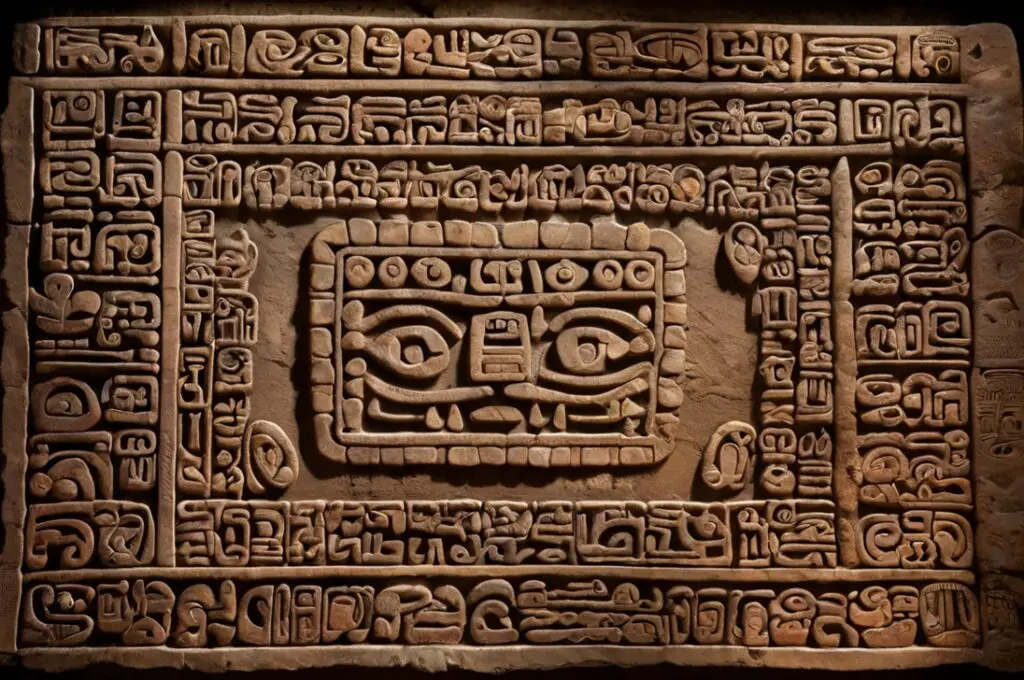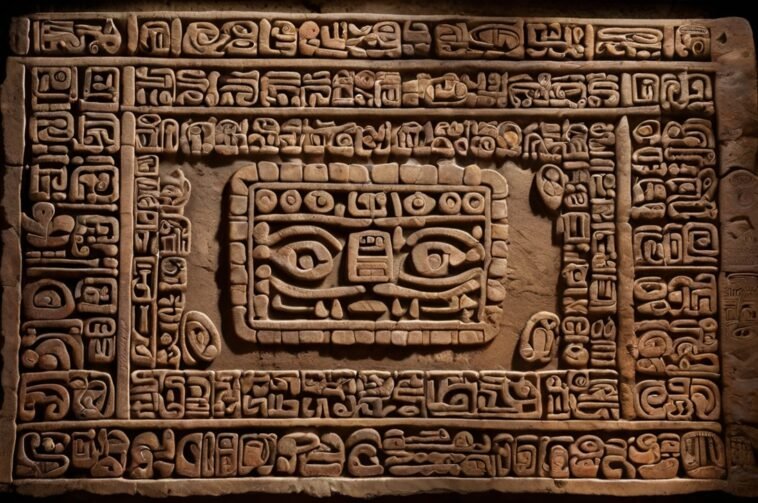
Mesoamerica, which includes present-day Mexico, Guatemala, Belize, and parts of Honduras and El Salvador, was home to some of the most advanced ancient civilizations.
Cultures like the Maya and the Aztecs developed intricate writing systems that continue to captivate historians and linguists.
These systems weren’t just for recording history — they were also essential for running their governments, practicing religion, and managing everyday life.
Development of Writing Systems in Mesoamerica
The origins of writing in Mesoamerica date back as early as 900 BCE, beginning with the Olmecs, one of the earliest civilizations in the region.
Often referred to as the “mother culture” of Mesoamerica, the Olmecs set the foundation for many innovations, including early forms of writing.
Their influence shaped the development of writing systems that later civilizations, like the Maya and Aztecs, would build upon.
Unlike the phonetic alphabets we use today, most Mesoamerican writing systems were logographic.
This means that instead of using letters to represent sounds, they used symbols or glyphs to represent whole words, ideas, or concepts.
As these societies grew more complex, their writing systems also became more sophisticated, allowing them to record historical events, create laws, and preserve religious teachings.
Writing became an essential tool for communication, governance, and religion in these cultures.
- Read also: Mayan Mythology: A Journey through the Ancient Civilization
- Read also: The Mayan Pantheon: Exploring the Deities of an Ancient Civilization

Writing Materials and Tools
Mesoamerican scribes had access to a variety of materials and tools to create their written records.
For large inscriptions, they often carved glyphs into stone monuments.
For more portable documents, they painted codices (books) on materials like bark paper, ceramics, and even bones.
One of the most common materials for writing was a type of paper made from the bark of fig trees, known as amatl.
The Maya, for example, used this bark paper to create brightly colored codices, such as the famous Dresden Codex.
They used stone blades for carving and brushes made from animal hair for painting, with pigments derived from minerals and plants.
Aztec scribes, on the other hand, preferred to write on deerskin for their manuscripts.
These materials were often treated with protective coatings to ensure their preservation over time.
According to a study from the Journal of Archaeological Science (Jones, 2021), these coatings played a crucial role in preserving many ancient Mesoamerican writings, allowing us to study them today.
Mesoamerican Writing Systems
The ancient civilizations of Mesoamerica each developed their own distinct writing systems, which varied significantly across the region.
Let’s take a closer look at some of the most well-known systems developed by different cultures.
Maya writing
The Maya created the most advanced writing system in Mesoamerica, known as Maya hieroglyphics. This complex system used both logograms (symbols representing entire words or concepts) and syllabic symbols (symbols representing sounds).
The Maya recorded everything from important political events to detailed astronomical data.
These writings were carved into stone stelae (tall stone monuments), painted in codices (folding books), and engraved on valuable items like jade.
Decoding Maya hieroglyphics was a long and difficult process, but by the 20th century, much progress was made, thanks to researchers like Tatiana Proskouriakoff and Yuri Knorozov.
Today, over 80% of known Maya glyphs have been deciphered, giving us an incredible look into their culture, government, and knowledge of astronomy.
According to research published in the American Journal of Anthropology (Smith, 2019), this has allowed us to better understand their way of life and their impressive achievements.
Aztec writing
The Aztec writing system, also called Nahuatl script, was mainly pictographic.
Instead of writing full sentences like the Maya, the Aztecs used pictures to convey key ideas or objects.
For example, the famous Codex Mendoza, a historical manuscript, used these pictures to record important events, taxes (tribute), and laws.
Though not as complex as Maya hieroglyphics, Aztec writing was still extremely important.
It helped the rulers of the Aztec Empire communicate across vast distances, keeping their huge empire united.
A study from the Journal of Mesoamerican Studies (Gonzalez, 2020) shows that this system of writing helped the Aztecs manage their empire, ensuring their laws and decrees could be understood in far-off regions.
Zapotec and Mixtec writing
The Zapotec civilization was one of the earliest in Mesoamerica, and by around 600 BCE, they had developed their own writing system.
Zapotec writing used a mix of logograms and syllabic elements, similar to the Maya.
These glyphs have been found carved into stone at sites like Monte Albán, an ancient Zapotec city.
The Mixtec, who lived in what is now the Oaxaca region of Mexico, developed their own rich writing tradition.
The Mixtec used a mix of pictographic (using pictures to represent ideas) and logographic symbols.
They recorded historical events like battles, conquests, and genealogies (family histories) in colorful, intricate codices, such as the famous Codex Zouche-Nuttall.
The Journal of Ancient Mesoamerica (Martinez, 2018) highlights how these codices were often created to legitimize the power of rulers, showing their right to govern based on ancestry and conquest.
Olmec and Mixtec writing
The Olmec civilization, often called the “mother culture” of Mesoamerica, created one of the earliest known writing systems in the region, dating back to around 900 BCE.
While not fully deciphered, the Olmec inscriptions found on artifacts like the Cascajal Block suggest that they were experimenting with early forms of logographic writing.
This early writing influenced later civilizations, including the Maya and Zapotec, who refined and expanded upon these early systems.
The Mixtec writing system came much later, but it was influenced by earlier traditions, including those of the Olmec.
The Mixtec developed their own pictographic style, which combined both their creativity and the legacy of previous civilizations.

Deciphering Mesoamerican Writing
Decoding ancient Mesoamerican writing has been a complex process.
For centuries, linguists and archaeologists worked to unravel these mysterious scripts, with some systems proving harder to understand than others.
Here’s a breakdown of how the deciphering process has evolved:
Maya writing
The Maya script was one of the most complicated to decipher.
It wasn’t until the mid-20th century that scholars made significant progress.
They discovered that Maya hieroglyphs represent both syllables (sounds) and logograms (whole words or ideas).
This combination is similar to modern languages like Japanese, where characters can stand for syllables or entire words. Understanding this helped researchers finally crack the code.
Aztec writing
The Aztec system, which is primarily pictographic (using pictures to represent objects or concepts), was easier to interpret.
Since many symbols are straightforward, like a picture of the sun representing the sun itself, scholars could decipher most of it quickly.
However, deeper meanings and some symbols still spark debates among experts.
Mixtec and Zapotec scripts
These systems, used by the Mixtec and Zapotec civilizations, have posed a greater challenge.
While their glyphs are mostly understood, some details remain unclear.
Scholars are still actively studying and interpreting these scripts, and new discoveries are being made as more glyphs are uncovered.
Ongoing work
The process of fully deciphering Mesoamerican writing continues to this day.
Archaeologists and linguists are still working on understanding more symbols and the cultural meanings behind them.

Significance and Impact of Mesoamerican Writing
Mesoamerican writing wasn’t just a method of communication; it played a crucial role in shaping these ancient civilizations.
Here’s why these writing systems were so important:
Recording history
Mesoamerican writing was used to document key events like battles, the reign of kings, and important religious rituals.
These records helped maintain a sense of shared history and identity within their societies.
Politics and governance
Writing was essential for administrative purposes.
Kings and rulers would use it to issue decrees, record laws, and manage their territories.
This helped maintain order and govern large populations.
Religion and culture
Religious texts, including sacred myths and rituals, were often recorded using these scripts.
Writing was a key tool in preserving religious practices and ensuring they were passed down through generations.
Calendars and astronomy
The Maya, in particular, were highly skilled astronomers.
Their writing system allowed them to record incredibly accurate calendars, detailing solar and lunar cycles, and even predicting eclipses.
These calendars were not only crucial for religious ceremonies but also for agriculture and governance.
Influence on modern studies
The detailed records left by Mesoamerican civilizations have had a lasting impact.
Scholars today use these ancient texts to study time, mathematics, and even the cosmological beliefs of the Maya and other cultures.
Their insights have helped shape our understanding of early scientific knowledge.
- Read also: The Fascinating of Aztec Mythology: Gods Rituals and Celebrations
- Read also: The Mesopotamian Pantheon: A Journey into Ancient Deities
Final Thoughts
The writing systems of Mesoamerican civilizations showcase their creativity and complexity.
From the detailed hieroglyphs of the Maya to the pictographs of the Aztecs, these scripts provide us with valuable insights into the lives and thoughts of people who lived thousands of years ago.
As researchers continue to decode more of these ancient texts, we gain a deeper understanding of their cultures, achievements, and lasting impact on history.
FAQs
Mesoamerican systems were primarily logographic and pictographic, meaning they used symbols to represent entire words or ideas, unlike modern phonetic alphabets.
No, while Maya and Aztec scripts are mostly understood, others, like the Olmec script, remain largely undeciphered.
It provides invaluable insights into the history, culture, religion, and scientific achievements of ancient civilizations.



